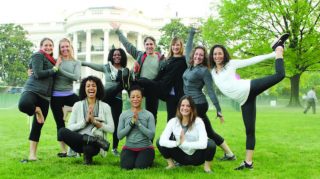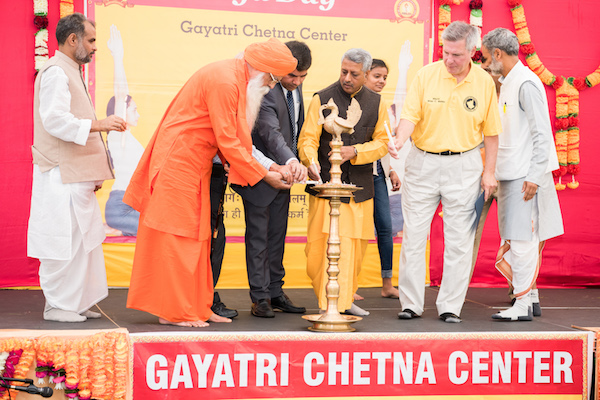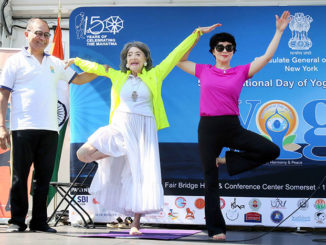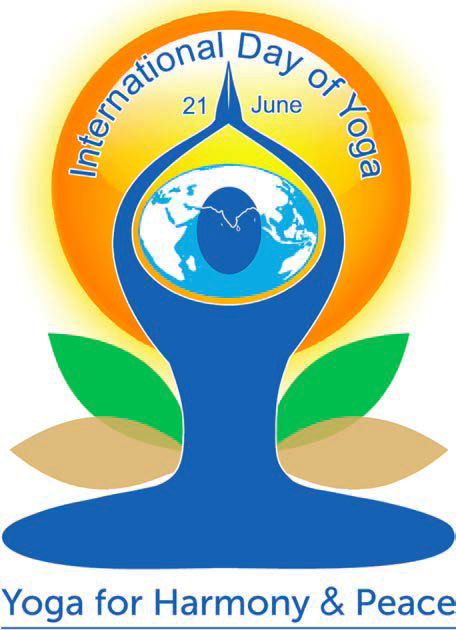
What is Yoga?
Yoga is essentially a spiritual discipline based on an extremely subtle science which focuses on bringing harmony between mind and body. It is an art and science for healthy living. The word “Yoga” is derived from the Sanskrit root yuj meaning “to join”, “to yoke” or “to unite”. According to Yogic scriptures, the practice of Yoga leads to the union of individual consciousness with universal consciousness. According to modern scientists, everything in the universe is just a manifestation of the same quantum firmament. One who experiences this oneness of existence is said to be “in Yoga” and is termed as a yogi who has attained a state of freedom, referred to as mukti, nirv?na, kaivalya or moksha.
“Yoga” also refers to an inner science comprising of a variety of methods through which human beings can achieve union between the body and mind to attain self-realization. The aim of Yoga practice (sadhana) is to overcome all kinds of sufferings that lead to a sense of freedom in every walk of life with holistic health, happiness and harmony.
Brief history and development of Yoga
The science of Yoga has its origin thousands of years ago, long before the first religion or belief systems were born. According to Yogic lore, Shiva has seen as the first yogi or
?diyogi and the first guru or ?diguru. Several thousand years ago, on the banks of lake Kantisarovar in the Himalayas, ?diyogi poured his profound knowledge into the legendary saptarishis or “seven sages”. These sages carried this powerful Yogic science to different parts of the world including Asia, the Middle East, northern Africa and South America. Interestingly, modern scholars have noted and marveled at the close parallels found between ancient cultures across the globe. However, it was in India that the Yogic system found its fullest expression. Agastya, the saptarishi who traveled across the Indian subcontinent, crafted this culture around a core Yogic way of life.
Yoga is widely considered as an “immortal cultural outcome” of the Indus Saraswati Valley Civilization – dating back to 2700 BC – and has proven itself to cater to both material and spiritual uplift of humanity. A number of seals and fossil remains of Indus Saraswati Valley Civilization with Yogic motifs and figures performing Yoga sadhana suggest the presence of Yoga in ancient India. The seals and idols of mother Goddess are suggestive of Tantra Yoga. The presence of Yoga is also available in folk traditions, Vedic and Upanishadic heritage, Buddhist and Jain traditions, Darshanas, epics of Mahabharata including Bhagawadgita and Ramayana, theistic traditions of Shaivas, Vaishnavas and Tantric traditions. Though Yoga was being practiced in the pre-Vedic period, the great sage Maharishi Patanjali systematized and codified the then existing Yogic practices, its meaning and its related knowledge through Patanjali’s Yoga Sutras.
After Patanjali, many sages and Yoga masters contributed greatly for the preservation and development of the field through well documented
Fundamentals of Yoga
Yoga works on the level of one’s body, mind, emotion and energy. This has given rise to four broad classifications of Yoga: Karma Yoga where we utilize the body; Jn?na Yoga where we utilize the mind; Bhakti Yoga where we utilize the emotion and Kriya Yoga where we utilize the energy. Each system of Yoga we practice falls within the gamut of one or more of these categories.
Every individual is a unique combination of these four factors. Only a guru (teacher) can advocate the appropriate combination of the four practices and literature. Yoga has spread all over the world by the teachings of eminent Yoga masters from ancient times to the present date. Today, everybody has conviction about Yoga practices towards the prevention of disease, maintenance and promotion of health. Millions and millions of people across the globe have benefited by the practice of Yoga and the practice of Yoga is blossoming and growing more vibrant with each passing day.
Traditional schools of Yoga
The different philosophies, traditions, lineages and guru-shishya paramparas of Yoga led to the emergence of different traditional schools. These include Jn?na Yoga, Bhakti Yoga, Karma Yoga, Patanjala Yoga, Kund? a? lini Yoga, Ha?ha Yoga, Dhyana Yoga, Mantra Yoga, Laya Yoga, Raja Yoga, Jain Yoga, Bouddha Yoga etc. Each school has its own approach and practices that lead to the ultimate aim and objectives of Yoga.
The widely practiced Yoga sadhanas are: Yama, Niyama, ?sana, Pr?n?y?ma, Praty?hara, Dh?rana, Dhy?na, Sam?dhi, Bandhas and Mudras, Shatkarmas, Yukt?h?ra, Mantra-japa, Yukta-karma etc. Yamas are restraints and Niyamas are
observances. These are considered to be pre-requisites for further Yogic practices. ?sanas, capable of bringing about stability of body and mind, “kuryat-tadasanam- sthairyam”, involve adopting various psycho-physical body patterns and giving one an ability to maintain a body position (a stable awareness of one’s structural existence) for a considerable length of time.
Pranayama consists of developing awareness of one’s breathing followed by willful regulation of respiration as the functional or vital basis of one’s existence. It helps in developin awareness of one’s mind and helps to establish control over the mind. In the initial stages, this is done by developing awareness of the “flow of in-breath and out-breath” (sv?sa-prasv?sa) through nostrils, mouth and other body openings, its internal and external pathways and destinations. Later, this phenomenon is modified, through regulated, controlled and monitored inhalation (sv?sa) leading to the awareness of the body space getting filled (puraka), the space(s) remaining in a filled state (kumbhaka) and it getting emptied (rechaka) during regulated, controlled and monitored exhalation (prasv?sa). Praty?hara indicates dissociation of one’s consciousness (withdrawal) from the sense organs which connect with the external objects.
Dh?rana indicates broad based field of attention (inside the body and mind) which is usually understood as concentration.
Dhyana (meditation) is contemplation (focused attention inside the body and mind) and Samadhi (integration).
Bandhas and Mudras are practices associated with Pranayama. They are viewed as the higher yogic practices that mainly adopt certain physical gestures along with control over respiration. This further facilitates control over mind and paves way for higher Yogic attainment. However, practice of dhy?na, which moves one towards self-realization and leads one to transcendence, is considered the essence of Yoga Sadhana. karmas are detoxification procedures that are clinical in nature and help to remove the toxins accumulated in the body. Yuktahara advocates appropriate food and food habits for healthy living.

General Guidelines for Yoga Practice
A Yoga practitioner should follow the guiding principles given below while performing Yogic practices:
BEFORE THE PRACTICE
- Sauca means cleanliness – an important prerequisite for Yogic practice. It includes cleanliness of surroundings, body and mind.
- Yogic practice should be performed in a calm and quiet atmosphere with a relaxed body and mind.
- Yogic practice should be done on an empty stomach or light stomach. Consume small amount of honey in lukewarm water if you feel weak.
- Bladder and bowels should be empty before starting Yogic practices.
- A mattress, Yoga mat, durrie or folded blanket should be used for the practice.
- Light and comfortable cotton clothes are preferred to facilitate easy movement of the body.
- Yoga should not be performed in state of exhaustion, illness, in a hurry or in acute stress conditions.
- In case of chronic disease/ pain/ cardiac problems, a physician or a Yoga therapist should be consulted prior to performing Yogic practices.
- Yoga experts should be consulted before doing Yogic practices during pregnancy and menstruation.
DURING THE PRACTICE
- Practice sessions should start with a prayer or invocation as it creates a conducive environment to relax the mind.
- Yogic practices shall be performed slowly, in a relaxed manner, with awareness of the body and breath.
- Breathing should be always through the nostrils unless instructed otherwise.
- Do not hold body tightly, or jerk the body at any point of time.
- Perform the practices according to your own capacity. ·It takes some time to get good results, so persistent and regular practice is very essential.
- There are contra-indications/ limitations for each Yoga practice and such contra-indications should always be kept in mind.
- Yoga session should end with meditation/ deep silence / ?h?nti pa?ha.
AFTER THE PRACTICE
- Bath may be taken only after 20-30 minutes of practice.
- Food may be consumed only after 20-30 minutes of practice.
FOOD FOR THOUGHT
A few dietary guidelines can ensure that the body and mind are flexible and well-prepared for practice. A vegetarian diet is usually recommended, and for a person over 30 years, two meals a day should suffice, except in cases of illness or very high physical activity or labor.
HOW YOGA CAN HELP
Yoga is essentially a path to liberation from all bondage. However, medical research in recent years has uncovered many physical and mental benefits that Yoga offers, corroborating the experiences of millions of practitioners. A small sampling of research shows that:
- Yoga is beneficial for physical fitness, musculoskeletal functioning and cardio-vascular health.
- It is beneficial in the management of diabetes, respiratory disorders, hypertension, hypotension and many lifestyle related disorders.
- Yoga helps to reduce depression, fatigue, anxiety disorders and stress.
- Yoga regulates menopausal symptoms.
- In essence, Yoga is a process of creating a body and mind that are stepping-stones, not hurdles, to an exuberant and fulfilling life.





Be the first to comment